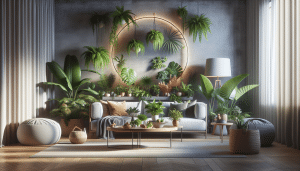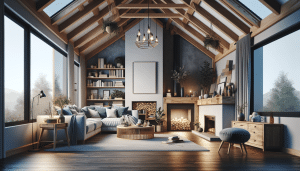Easy Upgrades That Quickly Boost Your Home Value
Henry King September 28, 2025
Curious about which improvements make your space more comfortable and potentially increase your home’s value? Discover easy home upgrades, energy-efficient changes, affordable landscaping tips, and smart renovations that can refresh your living area and attract positive attention.
Small Changes That Make a Big Impact
Sometimes, even the smallest upgrades can make a noticeable difference in the feel and function of your home. Swapping outdated hardware in kitchens or bathrooms, like drawer pulls and faucet handles, provides a surprisingly fresh look. A touch of modern style in these high-use spaces can attract favorable attention and create a pleasant day-to-day environment. Thoughtful touches like energy-efficient lighting, such as LED bulbs, not only help lower your utility bills but can also brighten rooms, making them more welcoming for both current residents and future visitors.
Smart thermostats offer another straightforward upgrade. By providing more precise control over home heating and cooling, these devices help optimize comfort and manage energy costs. Many homeowners report savings simply by programming daily schedules or using smartphone apps to monitor systems remotely. Better climate control can also be a compelling feature for anyone exploring new real estate listings, as energy efficiency consistently ranks high among desired amenities. Small steps like these may even qualify for incentive programs promoting efficient technology, making home improvements more affordable overall.
Wall color is another quick transformation. A new coat of paint in a trending neutral shade, like soft gray or clean white, can refreshing tired walls and create a versatile backdrop for any décor style. This update is simple enough for DIY enthusiasts and can foster a brighter, larger feeling in smaller rooms. The effect is immediate and impactful, making everyone feel more welcome and comfortable upon entering the space.
Affordable Landscaping Tips for Curb Appeal
First impressions count, and the space outside your front door sets the tone for the whole property. Refreshing landscaping doesn’t require an extensive investment or professional design. Simple steps—such as trimming overgrown bushes, pulling weeds, or edging the lawn—help exterior spaces look tidy and well loved. Placing colorful planters along the entryway or updating mulch around trees can further enhance curb appeal, inviting compliments from passing neighbors and guests alike.
Native and drought-tolerant plants are increasingly popular due to their lower maintenance costs and environmental benefits. These selections require less water and are better suited for the local climate, reducing the need for extensive care and complex irrigation systems. Many landscape experts suggest installing a few statement shrubs or perennial flowers for visual interest while keeping long-term maintenance minimal. These options create an attractive environment that encourages time outdoors without excessive effort.
Another affordable landscaping strategy is improving outdoor lighting. Solar-powered path lights or motion-detecting fixtures can make gardens or walkways safer and more visually appealing after dark. Enhanced lighting not only improves security but can extend the use of outdoor spaces for evening gatherings or relaxation. Tidy lawns and inviting entryways help everyone feel more at home and often create a positive impression on realtors and guests touring the property.
Energy-Efficient Upgrades for Lasting Savings
The value of energy-efficient changes goes beyond immediate cost reduction; these upgrades also demonstrate an eye toward sustainability and comfort. Installing double-glazed windows or adding insulation in key areas like the attic and basement are among the most effective ways to conserve energy. These improvements help maintain a steady indoor temperature and reduce the strain on heating and cooling systems, potentially resulting in lower monthly bills and a more comfortable living experience throughout the year.
Water conservation is another important area for homeowners. Low-flow toilets, faucets, and showerheads decrease demand without sacrificing performance, lessening the burden on both the wallet and community water resources. Utility providers and local governments sometimes offer rebates for switching to water-smart fixtures, so checking eligibility could help further offset upgrade costs. The wider adoption of these technologies is shaping modern home standards for resource efficiency and sustainability.
Many people explore adding solar panels to harness renewable energy, turning rooftops into tiny power stations. While the upfront investment may be significant, some regions offer incentives or tax credits to soften this impact. Over time, the switch to solar energy can reduce reliance on the grid and stabilize unpredictable power costs. More buyers are now seeking out homes with existing energy-efficient features, adding an extra layer of appeal to sustainably minded upgrades.
Smart Renovations That Add Functionality
Renovations focused on maximizing every square foot pay off in many ways, especially for growing families or work-from-home lifestyles. Converting unused nooks into compact home offices, laundry rooms, or mudrooms can boost everyday efficiency and reduce household stress. Multi-purpose spaces designed with built-in shelving, desks, or discreet storage add organizational value and create room for hobbies or remote work. These modifications support flexible living and can adapt to the changing needs of residents over time.
Open-concept living remains a strong trend, with many people seeking airy rooms for entertaining or relaxation. Removing a non-structural wall could instantly change how natural light flows through the house, making spaces feel larger and more connected. Even in smaller properties, swapping heavy window coverings for sheer drapes or sliding glass doors can visually expand the environment, improving both functionality and mood. These types of changes influence how people feel at home, which can be crucial during tours or appraisals.
Kitchens are often called the heart of the home. Upgrading appliances to models with high energy ratings or adding a new tile backsplash can elevate both form and function. Installing easy-to-clean, durable countertops or reorganizing storage for accessibility also modernizes kitchens, enhancing meal preparation and family life. Thoughtful kitchen changes often encourage more people to gather, highlighting the importance of communal spaces in contemporary home design.
Low-Cost Bathroom Refresh and Storage Ideas
Bathrooms don’t always need expensive remodeling to feel fresh. Installing a water-saving showerhead or switching to LED lighting can upgrade utilitarian spaces quickly. Accessories like new mirrors, towel hooks, or sleek shelving add both style and functionality on a modest budget. A well-lit bathroom that feels spacious and organized enhances comfort for everyone and stands out to visitors or appraisers when assessing the property.
Improving storage is another practical refresh. Adding recessed niches in showers or over-the-toilet shelving provides space for toiletries without cluttering countertops. Organizing products with matching baskets or labeled bins makes routines smoother and highlights a tidy lifestyle. Many real estate experts affirm that bathrooms offering both visual appeal and functional storage attract higher interest from those exploring the market. It’s about making the most of the room’s layout without major renovation costs.
Don’t underestimate the effect of caulking, grout, and fixture maintenance. Replacing worn-out sealing and attending to minor repairs keeps moisture where it belongs, protecting walls and floors from water damage. Simple upkeep prevents small issues from becoming costly repairs, and clean, well-cared-for bathrooms indicate overall diligence in home maintenance. Many people appreciate these details—sometimes even more than high-end finishes—when they are seeking a move-in-ready property.
Choosing Upgrades That Fit Your Goals
Selecting which improvements to undertake depends on personal goals, budget, and how long residents expect to remain in the home. Those interested in selling soon may prioritize projects that quickly create visual impact and offer broad appeal—like painting, landscaping, or lighting upgrades. Other homeowners focus on comfort and efficiency, making sure the space is functional for daily routines. Planning improvements around specific needs ensures satisfaction with the investment, regardless of when the home eventually changes hands.
Researching current trends and popular features in real estate can help inform choices. For example, open kitchens, smart home technology, and sustainable features are highly valued in many markets. However, not every trend suits every property. Consulting local professionals or reviewing reports from trusted organizations sheds light on which renovations genuinely help boost value in the local area. Balanced decision-making prevents over-investing and protects both short- and long-term interests.
Finally, it’s important to enjoy the process. Even modest upgrades can inspire a renewed sense of pride in one’s surroundings. Creative projects involving family or friends can foster connection and turn routine spaces into personal sanctuaries. Taking time to refresh home and garden areas—one step at a time—can yield both practical rewards and lasting satisfaction, adding value beyond simple financial return.
References
1. U.S. Department of Energy. (n.d.). Energy Saver Guide: Tips on Saving Money and Energy at Home. Retrieved from https://www.energy.gov/energysaver/energy-saver-guide
2. The National Association of Realtors. (2021). 2021 Profile of Home Staging. Retrieved from https://www.nar.realtor/research-and-statistics/research-reports/profile-of-home-staging
3. Environmental Protection Agency. (n.d.). WaterSense – Products. Retrieved from https://www.epa.gov/watersense/products
4. U.S. Department of Housing and Urban Development. (2023). Increasing Energy Efficiency in Existing Homes. Retrieved from https://www.huduser.gov/portal/pdredge/pdre_022118.html
5. American Society of Landscape Architects. (2020). Residential Landscape Architecture Trends Survey. Retrieved from https://www.asla.org/land/LandArticle.aspx?id=56485
6. Remodeling Magazine. (2022). Cost vs. Value Report. Retrieved from https://www.remodeling.hw.net/cost-vs-value/2022/







